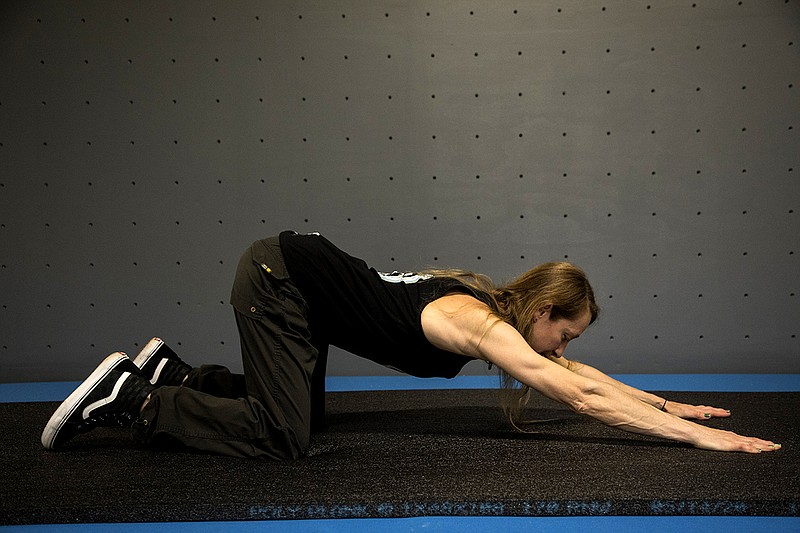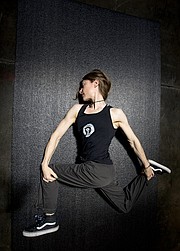As a professional climber for 30 years and a longtime climbing coach, Lisa Rands has honed a 30-minute routine of stretches and conditioning exercises that help climbers stay healthy and balanced.
Many climbers do exercises that focus on their front and abs, she says, but Rands likes her climbers to work those strengths while climbing. The conditioning exercises she recommends help with technique while focusing on strengthening through the back of the body and opening up the areas that get tight in the front, predominantly the chest and hips.
The most common problems she sees in climbers involve the shoulders, typically a result of not stretching sufficiently or performing pushing exercises to oppose all the pulling the shoulders typically do, she says. Even experienced climbers get imbalanced and start rolling their shoulders in as they pull, causing the pectoralis muscles to tighten and shorten - eventually leading to shoulder pain and possible injury such as rotator cuff tears or dislocation, says Rands.
"If you can practice climbing with good form and working through correct posture, you don't just target the front of the shoulder, you end up transferring the weight back through other key muscles such as your latissimus dorsi, middle and lower trapezius, and other key muscles in the back and sides such as through the serratus and obliques," she says. " ... You will overall be able to stay healthier. Plus, you'll climb harder because you end up recruiting bigger muscles, not just targeting smaller muscles in your shoulder."
A sign that someone is getting an imbalance, says Rands, is when they develop a big upper trap muscle, which happens because they are recruiting this muscle and neck muscles such as levator scapulae to pull themselves up rather than pulling down and back to transfer their weight into their lats and lower trapezius. Headaches could be another indicator, she says.
Here, Rands - who recently opened Synergy Climbing and Ninja on Chattanooga's Southside - shares a few of her favorite stretches and conditioning exercises to improve shoulder stability, climbing posture and overall health.
Stretch for lat and upper back
Kneel on the floor with your knees hip-width apart. Bow forward and extend your arms, palms down on the floor, with your head between your arms. Make sure you pull your shoulder blades down and back, but without letting your rib cage flare out. "This is stretching the lat muscle, but it can also stretch some other areas. You don't want to feel it pinching the top of your shoulders," Rands warns. This stretch should be held for a minimum of 30 seconds.
The Brettzel
A good overall stretch, the Brettzel hits the chest area, upper back and hips. Lying on the ground on your right side, bend your right leg behind you and grab the right ankle with your left hand. Bend your left leg at a 90-degree angle and cross it over to the right side of your body, gently pushing your left knee toward the floor using your right hand. Actively try to pull your shoulders toward the ground and push your hip down toward the floor so you get a spinal twist, making sure that the twist is not just through your lower back. "You're trying to really use muscles in your back to try to pull that shoulder down," Rands says. You can make it deeper by actively trying to pull the back leg open into a quad stretch and tucking the chin. This stretch can be held for up to 2 minutes per side.
Boat/Bow
Lie down on your stomach, grab your ankles and try to "inflate" through your back like a bow or a boat. "Again, this is using muscles through your back and through your glutes, but it's stretching through the front," she says. If your lower back is the hinge point, readjust into more of a rainbow shape. This stretch can be held for 30 seconds then released and repeated for another 30 seconds.
Bridge
Lying on your back with your feet flat on the floor, grab your ankles as you lift your body. The upper shoulders and feet remain on the floor as the chest moves toward the sky. You should feel your shoulders pulling together, stretching. You're also hitting your hips and psoas hip flexor muscle.
Backbend
A more aggressive version of the bridge is the backbend. "It is one of my favorites for people that are healthy enough to do it, because it opens up your chest and it also stretches your forearms," says Rands.
W-I-T-Y exercises
These essential exercises for climbers hit all the planes for scapular retraction, helping to keep your shoulders strengthened. "My experience has been, quite often a strengthening exercise isn't that effective if you don't have the mobility to get in the proper position for the strengthening," Rands says. So, she has the climbers she coaches stretch before doing conditioning exercises. "Over time, the more mobility you get, then you'll feel like these exercises are more effective."
With these exercises, concentrate on pulling the shoulders back and down, rather than up to the neck. "It's kind of a two-step process to think about first trying to get the arms engaged in a healthy position and then rolling the spine up in an arch position," says Rands.
She initially tells her athletes to hold their stretches for up to 15 seconds per exercise and do 3 sets - with the exception of the W plane, which is best performed by doing reps.
"Once they demonstrate good form, I change to having them do lifts and releases in all planes, focusing on 2 seconds up and 2 seconds to release. They build from 5 to 12 repetitions and 3 sets of exercises," she says.
W: To start, lie on your stomach with your arms stretched forward and your palms on the ground. Slowly lift your arms off the ground and pull your elbows down to create a 'W.' You should feel your lats engage on both sides and your scapulae pinching together. Slowly bring arms back to the starting position.
I: Lie on your stomach with your arms down by your side and slightly out, palms facing the floor, and engage your core while squeezing your glutes and keeping your legs together. Gently raise and lower your arms by squeezing your shoulder blades together while arching your upper back and legs up off the floor.
T: Bring your arms to either side, palms down. Again, squeezing through your middle back muscles, raise and lower your arms, meanwhile lifting your chest and legs off the ground.
Y: Now, form a 'Y' with your arms overhead, hands facing each other, and slowly raise and lower them while trying not to engage through your upper trap and neck muscles.

